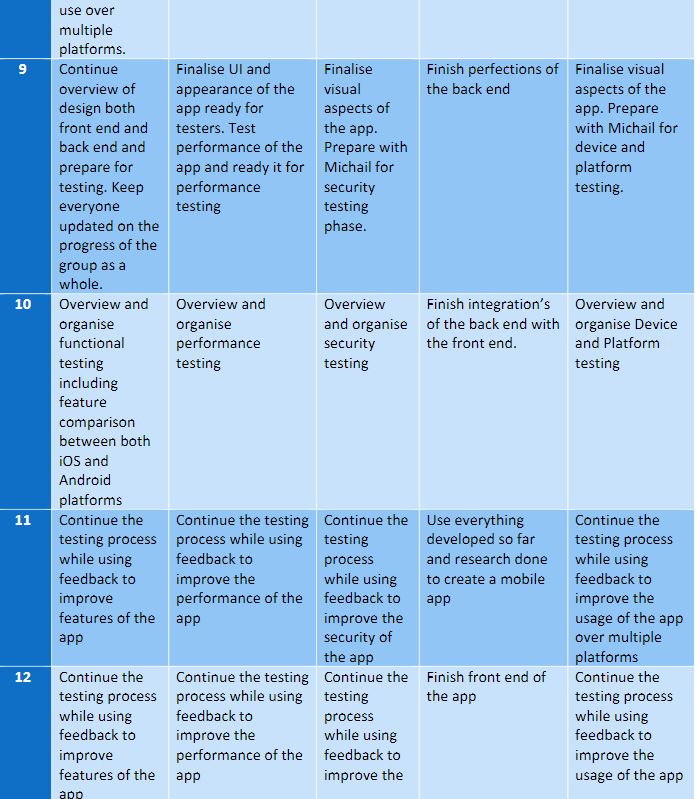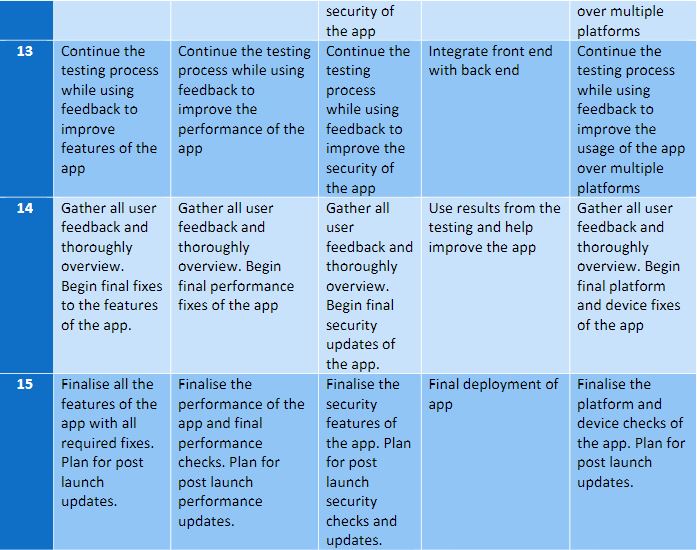Timeframe
According to (Team Invonto 2020) an effective development plan for an app will span six phases.
Phase 1 – Strategy
In this phase you create and define your strategy that will allow you to evolve an idea into successful app. Through this phase you will:
- Identify the target user of this app3
- Find and research the competitors in the market you are trying to penetrate
- Solidify the app’s objectives and what goals you have for this app
- Decide on the platform and devices for your app to be on.
(An average mobile app will cost around $150,000 to $200,000 to create with a production length from 4 to 6 months.)
Phase 2 – Analysis and Planning
In this phase the app transcends from idea into an actual project. This phase will begin with defining the cases in which your app will be used and solidifying detailed functional requirements. Part of this phase will involve gathering the requirements needed for your development of the app and hiring the development team. This phase includes the planning of your app name which will involve the research of each app store to find if your app’s name is already in use.
Phase 3 – UI/UX Design
The success of an app in the modern crowded market is defined by how well the users adopt and benefit from the app's features, this not only includes a polished user interface (UI) design but nailing an intuitive user experience (UX) and ensuring users’ stay engaged over time. Determining the data displayed by the mobile app, the data collected, user interactions with the app and the user journeys within the app, are the first steps of the design process. There are several design processes that occur during this phase:
- Wireframes – These are the digital form of sketches, conceptual layouts, otherwise referred to as low-fidelity mockups.
- Style Guide – Following a style guide will help maintain the look and feel of your app and ensure it remains consistent to your company’s brand image.
- Mock-ups – These are high-fidelity designs, usually the final renderings of the app’s visual appearance.
- Prototype – Prototypes are useful for giving the feel of the user experience and the app’s flow which will be expected from the finished product.
Phase 4 – App Development
Planning is still occurring during this phase of the process. Steps to take before development or programming occurs include:
- the technical architecture will need to be defined.
- technology stack planned out and known.
- definitive milestones set out for developers to aim foremost.
Three integral parts are common with a typical app development project back-end/server technology, APIs and the mobile app front end.
- Back end / Server Technology – The database and any other server-side objects that will be required to support the functionalities of the app.
- API –This is the method of communication from the app to the server/database.
- Mobile App Front-End – This is the front-end native mobile app that the users will see and interact with.
Phase 5 – Testing
There is a large variety of testing and testing phases, performance through QA testing will occur to ensure the app is stable, usable, and secure throughout the development process. The standard testing that occurs through most app development processes include:
- User Experience Testing – Ensuring the app matches the original designs and that it is consistent with the same theme throughout. This will be what end users experience when using the app.
- Functional Testing – This should be performed by as many users as possible to catch as many bugs as the testers can find. This will help ensure the apps features are functional and minimal issues occur upon release.
- Performance Testing –Testing the performance of your app will lower the risk of bad performance issues being experienced by the end users like slow loading screens, unresponsiveness and draining batteries of phones.
- Security Testing – With potential vulnerabilities leading to security exposure such as being hacked; the process of testing security should be taken seriously. While making sure the app is secure user ease of access should also be taken into consideration.
- Device and Platform Testing – With devices coming in different shapes and sizes and with a variety of operating systems this testing needs to cover all the devices and systems you plan on launching to.
Testing the app before launching is a large part of the app's success or failure and as such this phase is a substantial section of the overall mobile app development process helping deliver a quality mobile app.
Phase 6 – Deployment and Support
Will require the app to be submitted to stores with various data about the app which will then go through the review process, this process can take anywhere from few days to several weeks. Now that the users can obtain your app, constant monitoring of the app is required alongside frequent patches to improve the app.




Reference List
- Team Invonto 2020, Mobile App Development Process: A Step-by-Step Guide [2020], Invonto, viewed 12 November 2021, < https://www.invonto.com/insights/mobile-app-development-process/>.